Hardness and Indentation Fracture Toughness of Slip Cast Alumina and Alumina-Zirconia Ceramics
Abstract
1. Introduction
2. Materials and Methods
2.1. Ceramic Powder and Reagents
- High-purity Al2O3, with average particle size of 300–400 nm (Alcan Chemicals, Stamford, CT, USA)
- High-purity ZrO2 stabilized with 3 mol % of yttria (Y2O3), with average particle size of 25 nm (SkySpring Nanomaterials Inc., Houston, TX, USA)
- An alkali-free anionic polyelectrolyte dispersant Dolapix CE 64 (Zschimmer & Schwarz GmbH &Co KG Chemische Fabriken, Lahnstein, Germany)–70 wt. % aqueous solution of the ammonium salt of polymethacrylic acid (PMAA-NH4)
- Magnesium oxide added as magnesium aluminate spinel (MgAl2O4) made by Alfa Aesar, Haverhill, MA, USA was used to inhibit the abnormal alumina grain growth during the sintering process [22]. Magnesium spinel is segregated on the grain boundaries of alumina grains and reducing the mobility of the grain boundaries
- Deionized water
2.2. Suspension Preparation and Characterization
- 100 wt. % Al2O3
- 99 wt. % Al2O3 and 1 wt. % of ZrO2
- 95 wt. % Al2O3 and 5 wt. % of ZrO2
- 90 wt. % Al2O3 and 10 wt. % of ZrO2.
2.3. Sintering of Monolithic Alumina and Composite Alumina-Zirconia Ceramics
2.4. Characterisation of Monolithic Alumina and Composite Alumina-Zirconia Ceramics
3. Results and Discussion
4. Conclusions
- XRD analysis confirmed that alumina powder consists of α-phase alumina (corundum). The XRD results confirm the changing levels of alumina and zirconia in the composites, and point out to the stable ratio between main tetragonal phase and monoclinic zirconia phase in traces. In addition, the change of the crystallite sizes because of the zirconia loading was quantified.
- With the addition of the commercial dispersant DOLAPIX CE 64, it is possible to prepare stable 70 wt. % aqueous suspensions of monolithic Al2O3 and composite Al2O3-ZrO2 ceramics using commercial powders.
- 0.25 wt. % of DOLAPIX CE 64 dispersant is required to stabilize the 70 wt. % aqueous suspensions of monolithic Al2O3 ceramics.
- 0.3 wt. % of DOLAPIX CE 64 dispersant is required to stabilize the 70 wt. % aqueous suspensions of composite Al2O3–ZrO2 ceramics, composed of 99 wt. % Al2O3 and 1 wt. % ZrO2.
- 0.7 wt. % of DOLAPIX CE 64 dispersant is required to stabilize the 70 wt. % aqueous suspensions of composite Al2O3–ZrO2 ceramics, composed of 95 wt. % Al2O3 and 5 wt. % ZrO2
- 1 wt. % of DOLAPIX CE 64 dispersant is required to stabilize 70 wt. % aqueous suspensions of composite Al2O3–ZrO2 ceramics, composed of 90 wt.% Al2O3 and 10 wt.% ZrO2.
- Apparent viscosity and the required amount of Dolapix CE 64 increase with increasing the zirconia content.
- Green bodies of monolithic Al2O3 and composite Al2O3-ZrO2 ceramics were formed by slip casting process in plaster molds. After drying, the green bodies were sintered at a temperature of 1650 °C.
- SEM-EDS analysis of prepared composite ceramics showed that ZrO2 particles are dispersed in Al2O3 matrix with some agglomerates of ZrO2, and pores.
- The obtained c/a values ranging from 2.3 to 3.9 indicate that the Langford model is the most appropriate model for the indentation fracture toughness, because this model can be applied to both median and Palmquist crack types.
- By adding ZrO2 nanoparticles in alumina matrix, the hardness has decreased because the hardness of tetragonal zirconia is lower than alumina. Also, the addition of ZrO2 nanoparticles has caused an increase in total porosity, hence lowering the hardness.
- On the other hand, the fracture toughness of alumina matrix has increased by adding ZrO2 nanoparticles as a result of the synergistic effect of transformation toughening and the microstructural changes.
Author Contributions
Funding
Acknowledgments
Conflicts of Interest
References
- Majić, M.; Ćurković, L. Fracture Toughness of Alumina Ceramics Determined by Vickers Indentation Technique. Mater. Test. 2012, 54, 228–232. [Google Scholar] [CrossRef]
- Moraes, M.C.C.; Elias, C.N. Mechanical properties of alumina-zirconia composites for ceramic abutments. Mat. Res. 2004, 7, 643–649. [Google Scholar] [CrossRef]
- Ramesh, S.; Siah, L.F.; Nor Azmah, A.K. Sintering behaviour of slip-cast Al2O3-Y-TZP composites. J. Mater. Sci. 2000, 35, 5509–5515. [Google Scholar] [CrossRef]
- Piconi, C.; Maccauro, G. Review: Zirconia as a ceramic biomaterial. Biomaterials 1999, 20, 1–25. [Google Scholar] [CrossRef]
- Sommer, F.; Landfried, R.; Kern, F.; Gadow, R. Mechanical properties of zirconia toughened alumina with 10-24vol% 1Y-TZP reinforcement. J. Eur. Ceram. Soc. 2012, 32, 4177–4184. [Google Scholar] [CrossRef]
- Kern, F.; Palmero, P.; Marro, F.G.; Mestra, A. Processing of alumina-zirconia composites by surface modification route with enhanced hardness and wear resistance. Ceram. Int. 2015, 41, 889–898. [Google Scholar] [CrossRef]
- Malhotra, S.K.; Singh, P.; Thirunavukkarasu, A. Synthesis of alumina-zirconia nanocomposites by sol gel process. Mater. Manuf. Process. 2006, 21, 652–657. [Google Scholar] [CrossRef]
- Sarraf, H.; Herbig, R.; Maryška, M. Fine-grained Al2O3–ZrO2 composites by optimization of the processing parameters. Scr. Mater. 2008, 59, 155–158. [Google Scholar] [CrossRef]
- Kern, F.; Palmero, P. Microstructure and mechanical properties of alumina 5 vol% zirconia nanocomposites prepared by powder coating and powder mixing routes. Ceram. Int. 2013, 39, 673–682. [Google Scholar] [CrossRef]
- Khan, A.U.; Haq, A.U.; Mahmood, N.; Ali, Z. Rheological studies of aqueous stabilised nano-zirconia particle suspensions. Mater. Res. 2012, 15, 21–26. [Google Scholar] [CrossRef]
- Majić Renjo, M.; Lalić, M.; Ćurković, L.; Matijašić, G. Rheological properties of aqueous alumina suspensions. Materwiss. Werksttech. 2012, 43, 979–983. [Google Scholar] [CrossRef]
- Tallon, C.; Limacher, M.; Franks, G.V. Effect of particle size on the shaping of ceramics by slip casting. J. Eur. Ceram. Soc. 2010, 30, 2819–2826. [Google Scholar] [CrossRef]
- Reed, J.S. Principles of Ceramics Processing, 2nd ed.; John Wiley & Sons Inc.: New York, NY, USA, 1995; pp. 154–196. [Google Scholar]
- Prakash Rao, S.; Tripathy, S.S.; Raichur, A.M. Dispersion studies of sub-micron zirconia using Dolapix CE 64. Coll. Surf. Physicochemi. Eng. Asp. 2007, 302, 553–558. [Google Scholar]
- Binner, J.G.P.; McDermott, A.M. Rheological characterisation of ammonium polyacrylate dispersed, concentrated alumina suspensions. Ceram. Int. 2006, 32, 803–810. [Google Scholar] [CrossRef]
- Holmberg, K. Handbook of Applied Surface and Colloid Chemistry, 1st ed.; John Wiley & Sons: Chichester, UK, 2002; pp. 57–70. [Google Scholar]
- Karimian, H.; Babaluo, A.A. Effect of polymeric binder and dispersant on the stability of colloidal alumina suspensions. Iran Polym. J. 2006, 15, 879–889. [Google Scholar]
- Shojai, F.; Pettersson, A.B.A.; Mäntylä, T.; Rosenholm, J.B. Electrostatic and electrosteric stabilization of aqueous slips of 3Y–ZrO2 powder. J. Eur. Ceram. Soc. 2000, 20, 277–283. [Google Scholar] [CrossRef]
- Singh, B.P.; Bhattacharjee, S.; Besra, L.; Sengupta, D.K. Electrokinetic and adsorption studies of alumina suspensions using Darvan C as dispersant. J. Colloid Interface Sci. 2005, 289, 592–596. [Google Scholar] [CrossRef]
- Tsetsekou, A.; Agrafiotis, C.; Leon, I.; Milias, A. Optimization of the rheological properties of alumina slurries for ceramic processing applications Part II: Spray-drying. J. Eur. Ceram. Soc. 2004, 21, 493–506. [Google Scholar] [CrossRef]
- Briscoe, B.J.; Khan, A.U.; Luckham, P.F. Optimising the dispersion on an alumina suspension using commercial polyvalent electrolyte dispersants. J. Eur. Ceram. Soc. 1998, 18, 2141–2147. [Google Scholar] [CrossRef]
- Vukšić, M.; Žmak, I.; Ćurković, L.; Ćorić, D. Effect of Additives on Stability of Alumina—Waste Alumina Suspension for Slip Casting: Optimization Using Box-Behnken Design. Materials 2019, 12, 1738. [Google Scholar] [CrossRef]
- Sever, I.; Žmak, I.; Ćurković, L.; Švagelj, Z. Stabilization of Highly Concentrated Alumina Suspensions by Different Dispersants. Trans. FAMENA 2018, 42, 61–70. [Google Scholar] [CrossRef]
- Chou, K.; Lee, L. Effect of Dispersants on the Rheological Properties and Slip Casting of Concentrated Alumina Slurry. J. Am. Ceram. Soc. 1989, 72, 1622–1627. [Google Scholar] [CrossRef]
- Guo, L.C.; Zhang, Y.; Uchida, N.; Uematsu, K. Adsorption Effects on the Rheological Properties of Aqueous Alumina Suspensions with Polyelectrolyte. J. Am. Ceram. Soc. 2005, 81, 549–556. [Google Scholar] [CrossRef]
- Majić Renjo, M.; Ćurković, L.; Andrić, I. Preparation of stable suspensions for slip casting of alumina zirconia composite. In Proceedings of the 4th International Scientific and Expert, Technique, Education, Agriculture & Management—TEAM 2012 Conference, Slavonski Brod, Croatia, 17–19 October 2012; Živić, M., Galeta, T., Eds.; Strojarski fakultet: Slavonski Brod, Croatia, 2012; pp. 81–84. [Google Scholar]
- Moreno, R.; Salomoni, A.; Stamenkovic, I. Influence of slip rheology on pressure casting of alumina. J. Eur. Ceram. Soc. 1997, 17, 327–331. [Google Scholar] [CrossRef]
- Chinn, R.E. Ceramography: Preparation and Analysis of Ceramic Microstructures, 1st ed.; ASM International: Materials Park, OH, USA, 2002; pp. 35–67. [Google Scholar]
- Ćorić, D.; Majić Renjo, M.; Ćurković, L. Vickers indentation fracture toughness of Y-TZP dental ceramics. Int. J. Refract. Met. Hard Mater. 2017, 64, 14–19. [Google Scholar] [CrossRef]
- Casellas, D.; Nagl, M.M.; Llanes, L.; Anglada, M. Microstructural coarsening of zirconia-toughened alumina composites. J. Am. Ceram. Soc. 2005, 88, 1958–1963. [Google Scholar] [CrossRef]
- Jindal, P.C. A New Method for Evaluating the Indentation Toughness of Hardmetals. Crystals 2018, 8, 197. [Google Scholar] [CrossRef]
- Şakar-Deliormanli, A.; Güden, M. Microhardness and fracture toughness of dental materials by indentation method. J. Biomed. Mater. Res. Part B Appl. Biomater. 2006, 76, 257–264. [Google Scholar] [CrossRef]
- Anstis, G.R.; Chantikul, P.; Lawn, B.R.; Marshall, D.B. A critical evaluation of indentation techniques for measuring fracture toughness: I, direct crack measurements. J. Am. Ceram. Soc. 1981, 64, 533–538. [Google Scholar] [CrossRef]
- Sergejev, F.; Antonov, M. Comparative study on indentation fracture toughness measurements of cemented carbides. Proc. Est. Acad. Sci. Eng. 2006, 12, 388–398. [Google Scholar]
- Niihara, K.; Morena, R.; Hasselman, D.P.H. Evaluation of KIC of brittle solids by the indentation method with low crack-to-indent ratios. J. Mater. Sci. Lett. 1982, 1, 13–16. [Google Scholar] [CrossRef]
- Roberts, O.; Lunt, A.J.G.; Ying, S.; Sui, T.; Baimpas, N.; Dolbnya, I.P.; Parkes, M.; Dini, D.; Kreynin, S.M.; Neo, T.K.; et al. A Study of Phase Transformation at the Surface of a Zirconia Ceramic. In World Congress on Engineering, WCE 2014, Proceedings of the World Congress on Engineering, London, UK, 2–4 July 2014; Ao, S.I., Gelman, L., Hukins, D.W.L., Hunter, A., Korsunsky, A.M., Eds.; Newswood Limited: Hong Kong, China, 2014; Volume 2, pp. 1173–1177. [Google Scholar]
- Liu, W.C.; Wu, D.; Li, A.D.; Ling, H.Q.; Tang, Y.F.; Ming, N.B. Annealing and doping effects on structure and optical properties of sol-gel derived ZrO2 thin films. Appl. Surf. Sci. 2002, 191, 181–187. [Google Scholar] [CrossRef]
- Manjula, S.; Mahesh Kumar, S.; Raichur, A.M.; Madhu, G.M.; Suresh, R.; Lourdu Anthony Raj, M.A. A sedimentation study to optimize the dispersion of alumina nanoparticles in water. Cerâmica 2005, 51, 121–127. [Google Scholar] [CrossRef]
- Pabst, W.; Gregorová, E.; Malangré, D.; Hostaša, J. Elastic properties and damping behavior of alumina–zirconia composites at room temperature. Ceram. Int. 2012, 38, 5931–5939. [Google Scholar] [CrossRef]
- Moazzam Hossen, M.; Chowdhury, F.U.Z.; Gafur, M.A.; Abdul Hakim, A.K.M.; Belal Hossen, M. Effect of Zirconia Substitution on Structural and Mechanical Properties of ZTA Composites. IOSR J. Mech. Civ. Eng. 2014, 11, 01–07. [Google Scholar] [CrossRef]
- Naglieri, V.; Palmero, P.; Montanaro, L.; Chevalier, J. Elaboration of Alumina-Zirconia Composites: Role of the Zirconia Content on the Microstructure and Mechanical Properties. Materials 2013, 6, 2090–2102. [Google Scholar] [CrossRef]
- Ahmad, I.; Islam, M.; Habis, N.A.; Parvez, S. Hot-Pressed Graphene nanoplatelets or/and Zirconia Reinforced Hybrid Alumina Nanocomposites with Improved Toughness and Mechanical Characteristics. J. Mater. Sci. 2018. [Google Scholar] [CrossRef]
- Matsumoto, Y.; Hirota, K.; Yamaguchi, O. Mechanical Properties of Hot Isostatically Pressed Zirconia-Toughened Alumina Ceramics Prepared from Coprecipitated Powders. J. Am. Ceram. Soc. 1993, 76, 2677–2680. [Google Scholar] [CrossRef]
- Takano, Y.; Ozawa, T.; Yoshinaka, M.; Hirota, K.; Yamaguch, O. Microstructure and Mechanical Properties of ZrO2(2Y)-Toughened A12O3 Ceramics Fabricated by Spark Plasma Sintering. J. Mater. Synth. Process. 1999, 7, 107–111. [Google Scholar] [CrossRef]
- Tang, Y.; Yonezu, A.; Ogasawara, N.; Chiba, N.; Chen, X. On radial crack and half-penny crack induced by Vickers indentation. Proc. R. Soc. A Math. Phys. Eng. Sci. 2008, 464, 2967–2984. [Google Scholar] [CrossRef]
- Elsaka, S.E.; Elnaghy, A.M. Mechanical properties of zirconia reinforced lithium silicate glass-ceramic. Dent. Mater. 2016, 32, 908–914. [Google Scholar] [CrossRef] [PubMed]

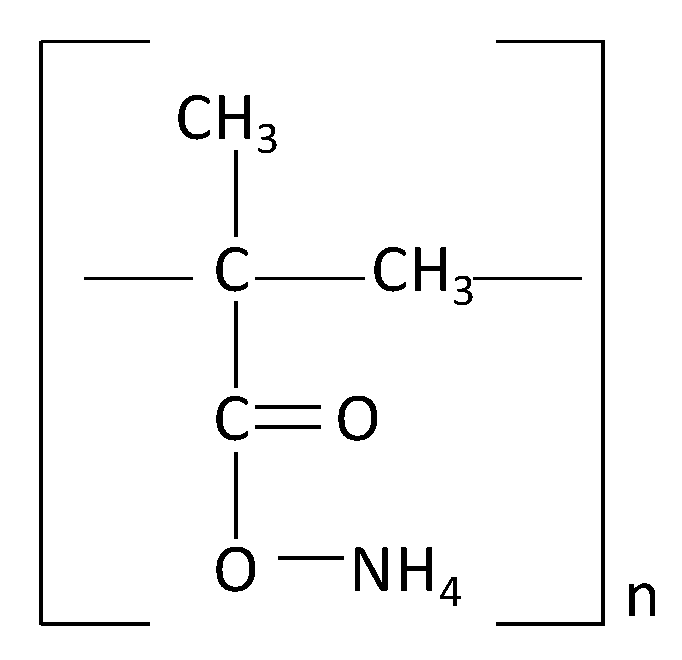
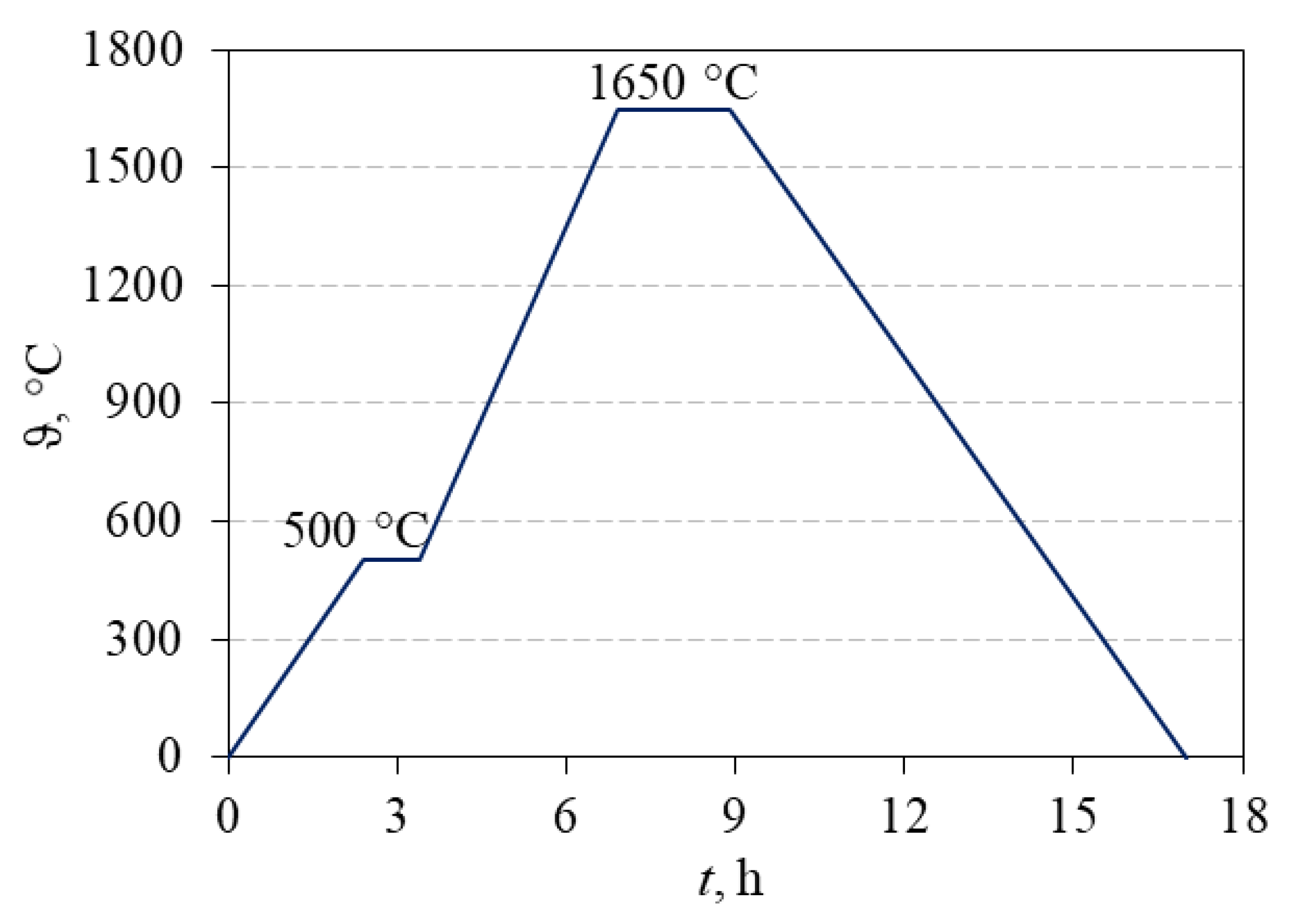
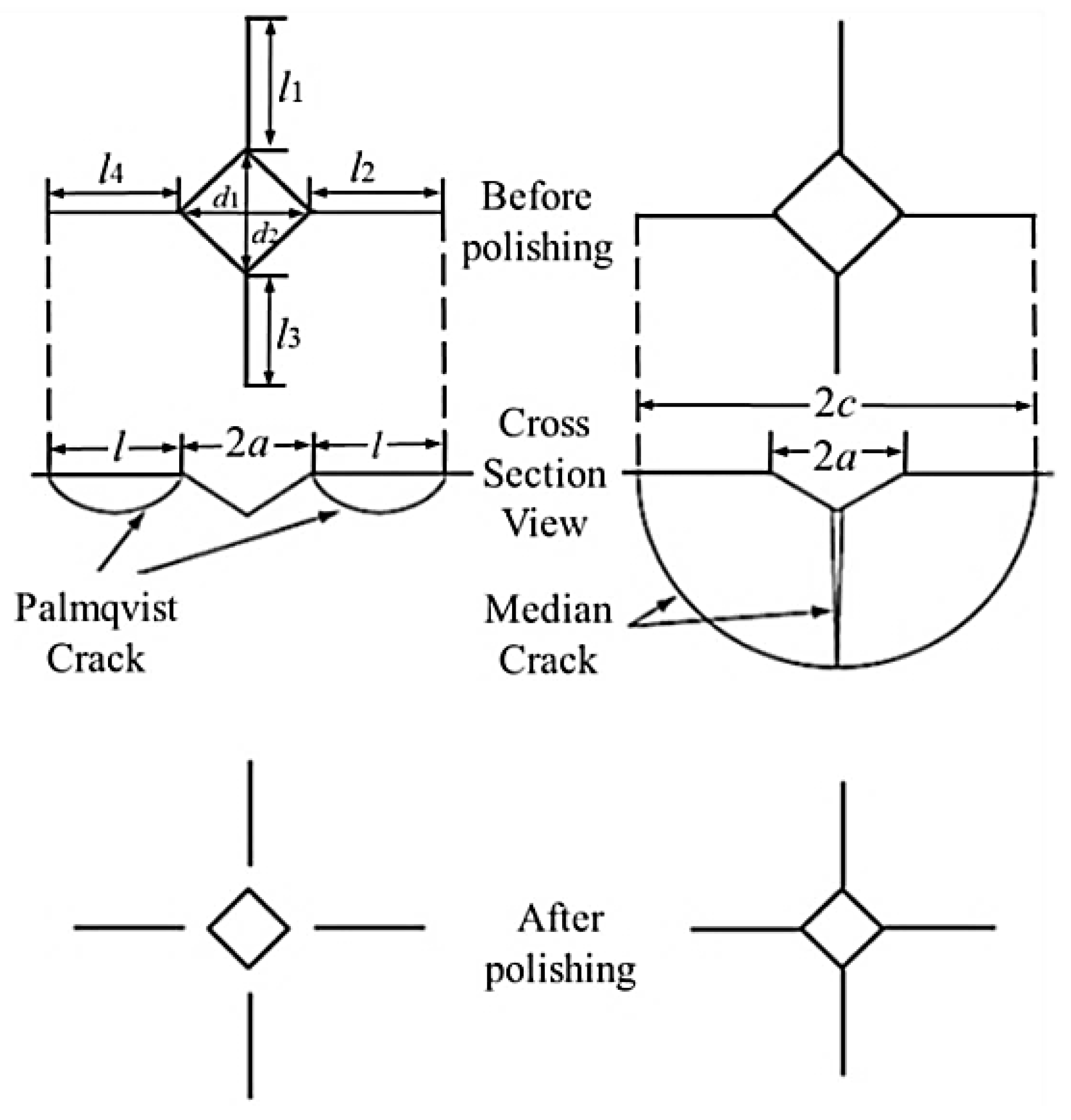
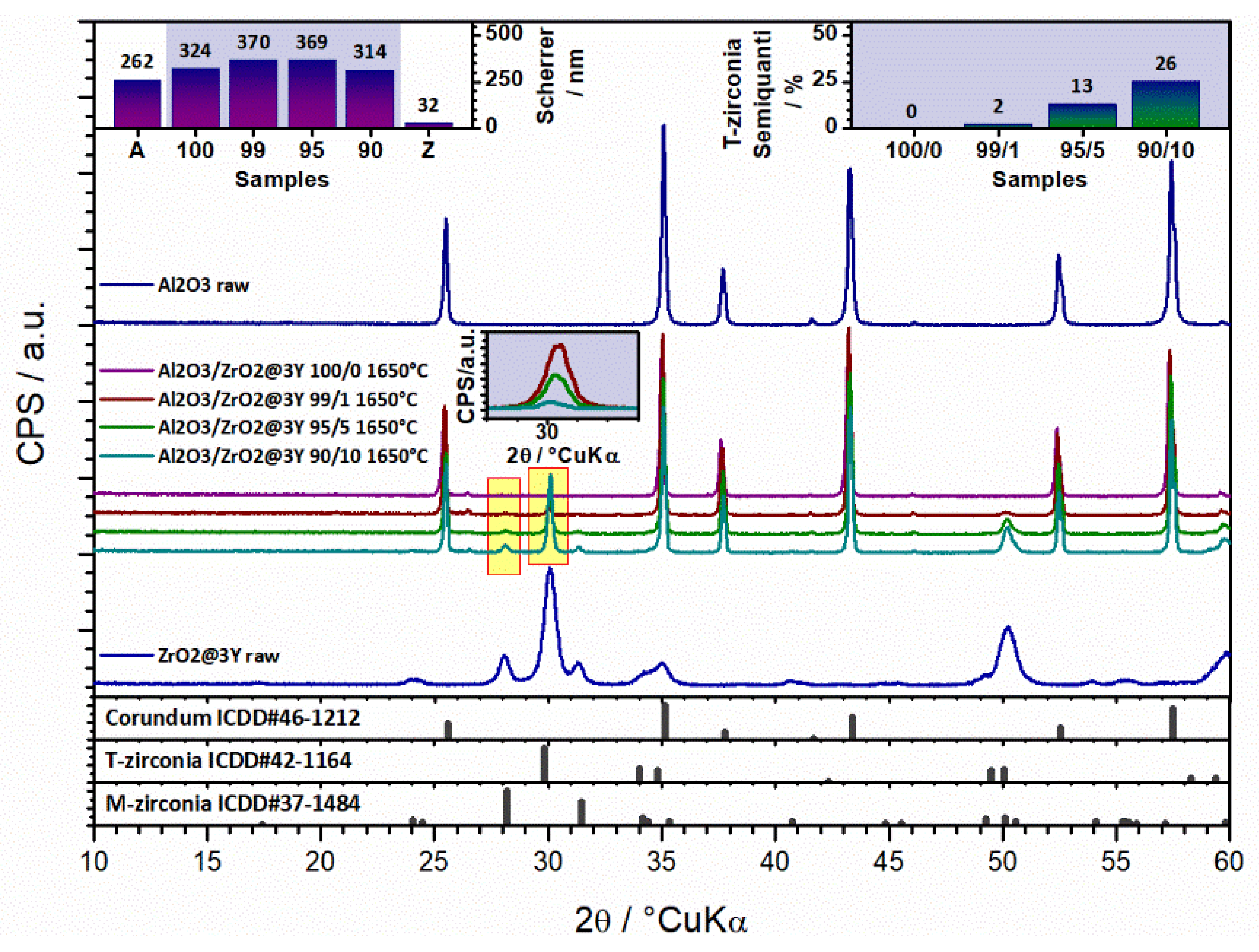
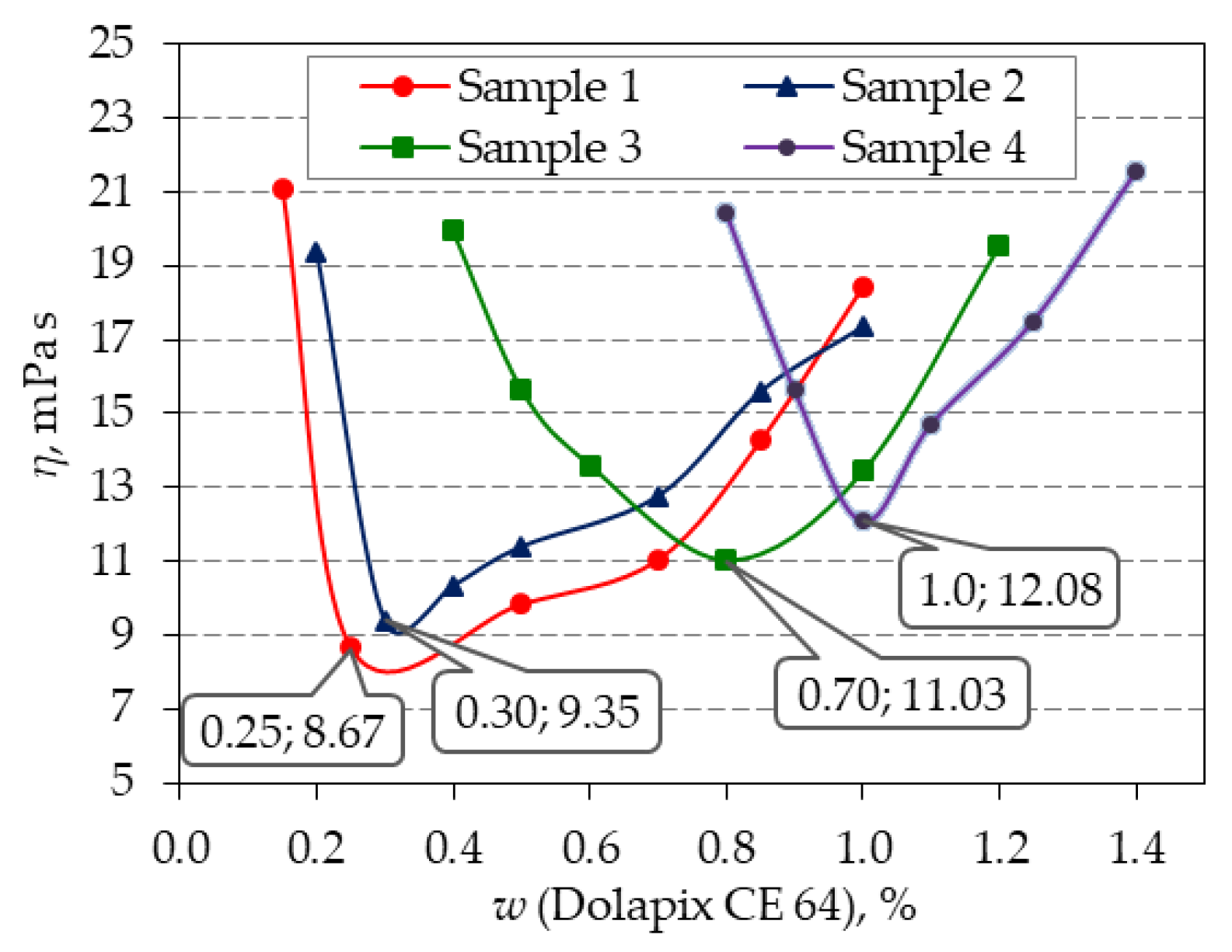

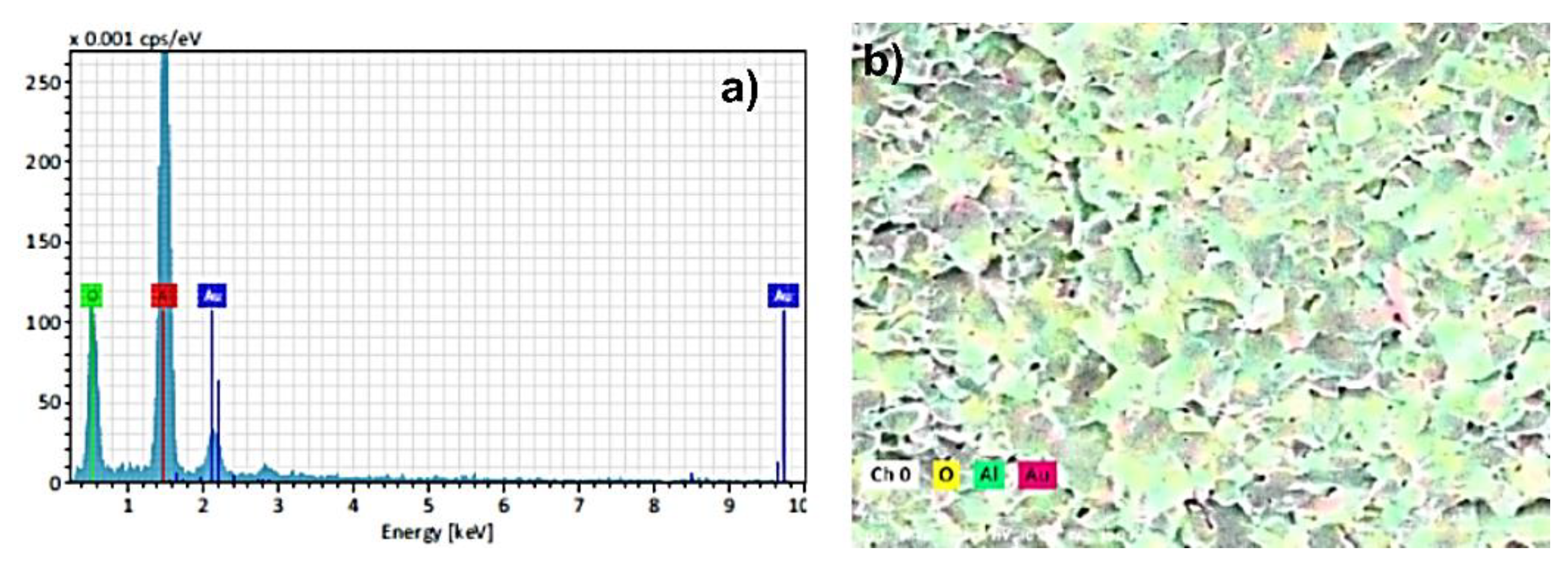
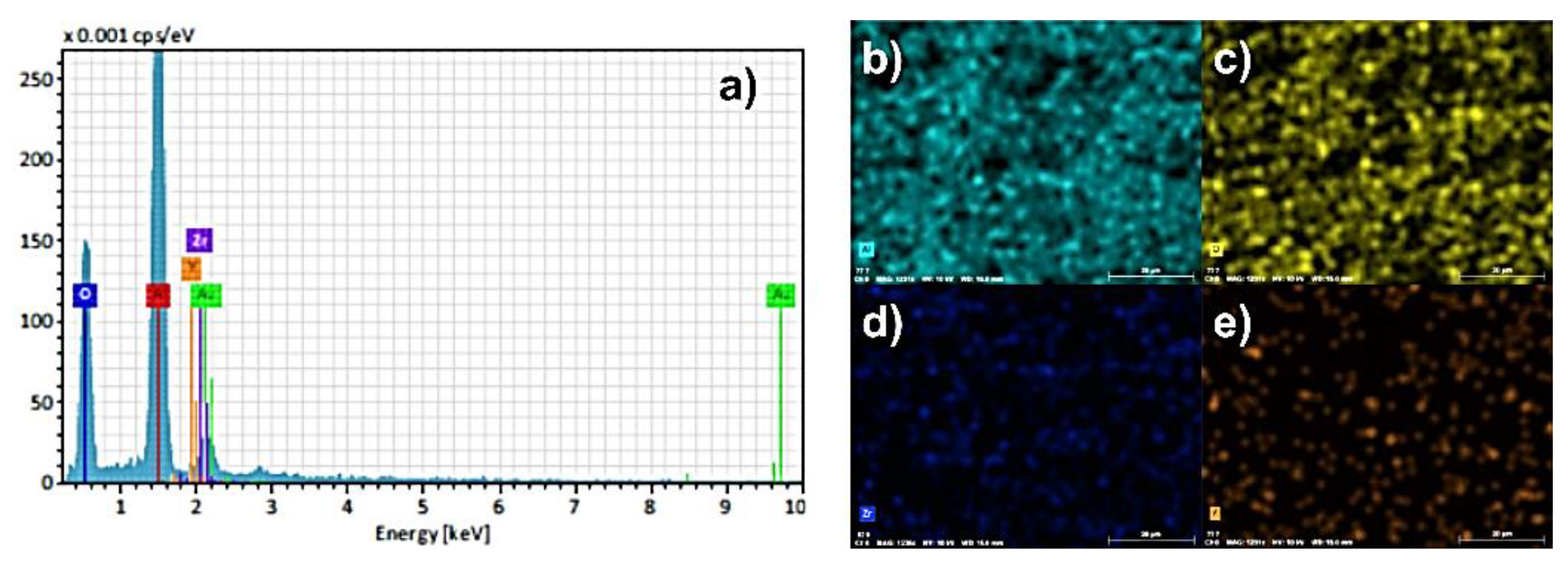
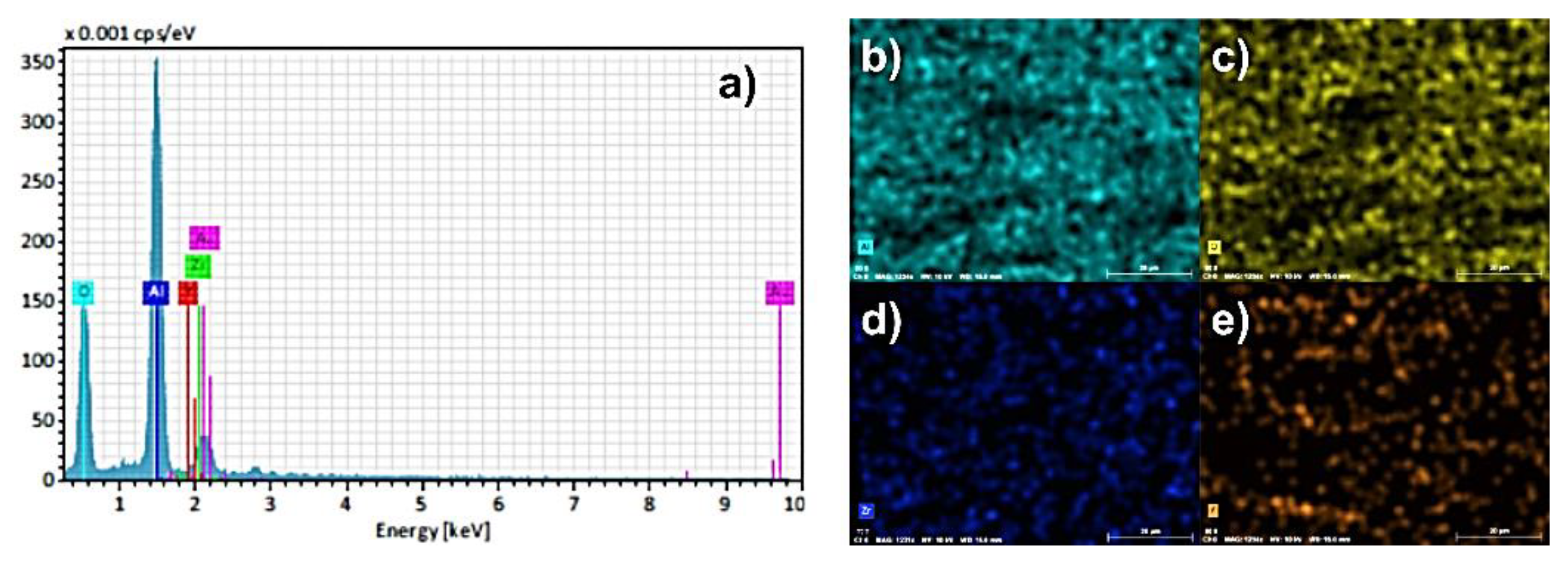
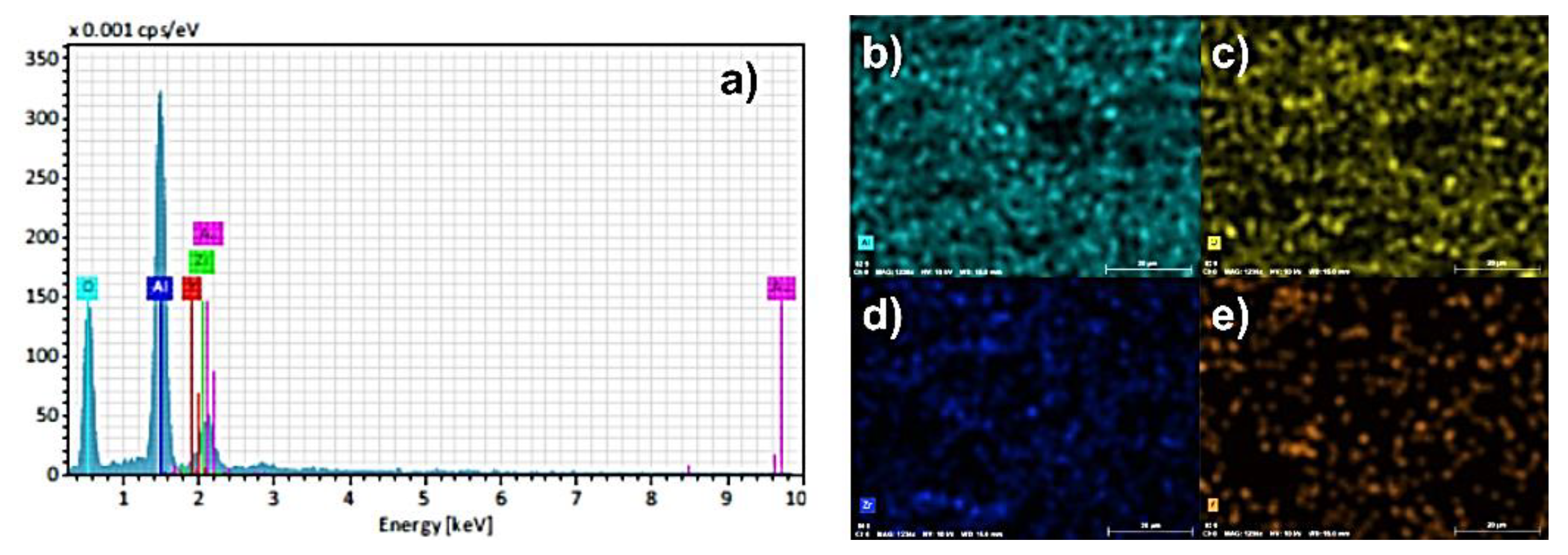
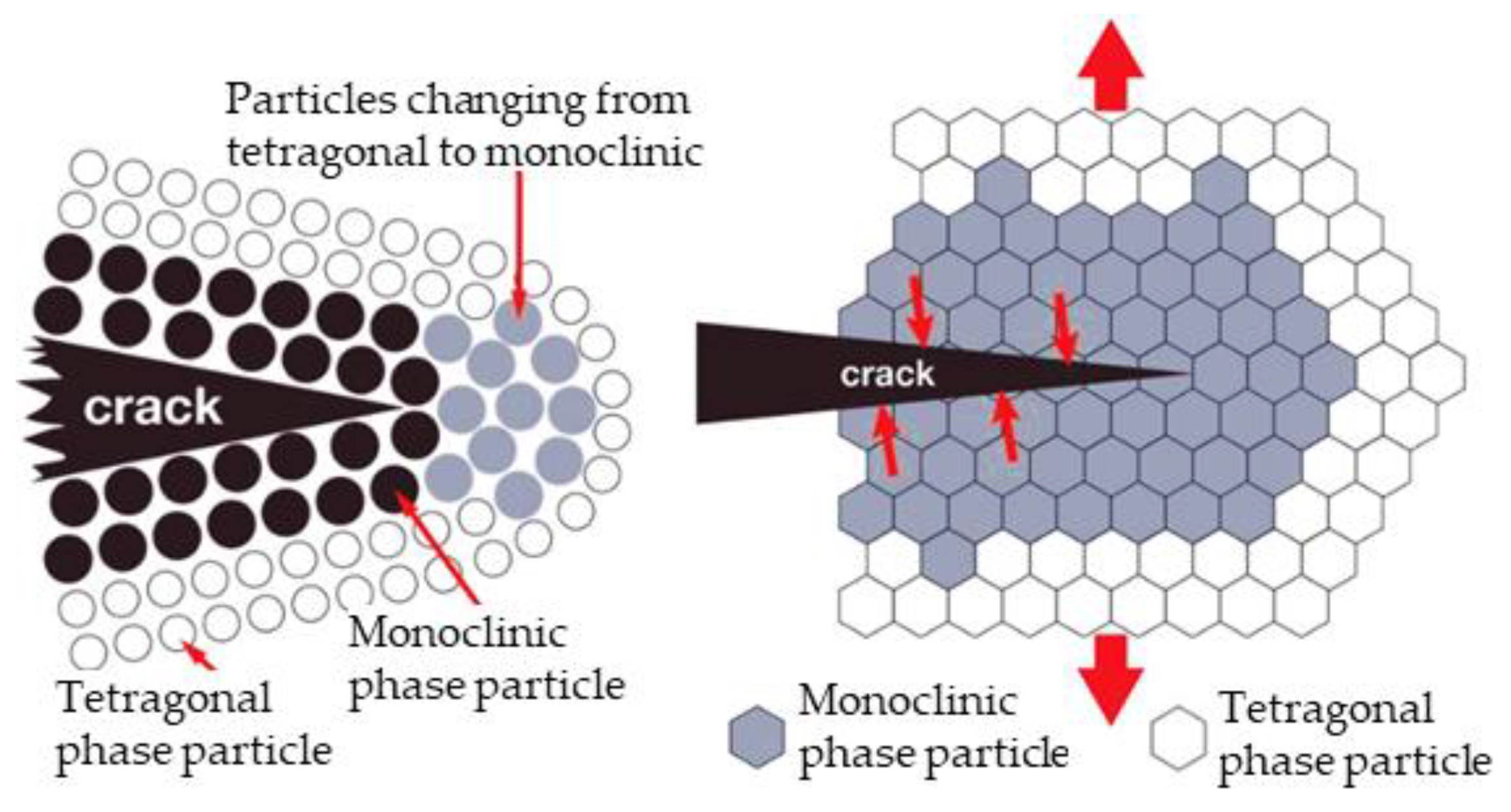
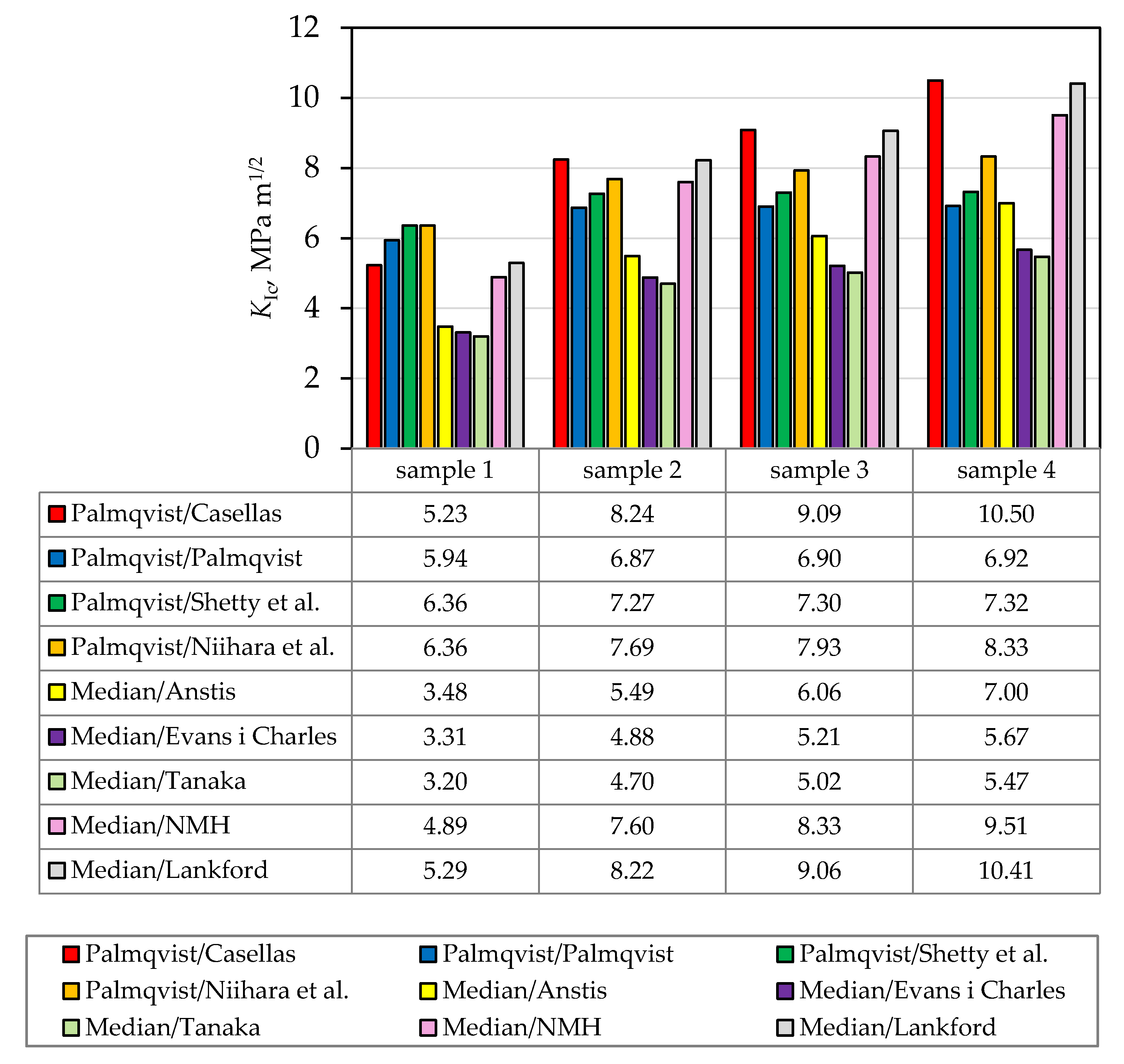
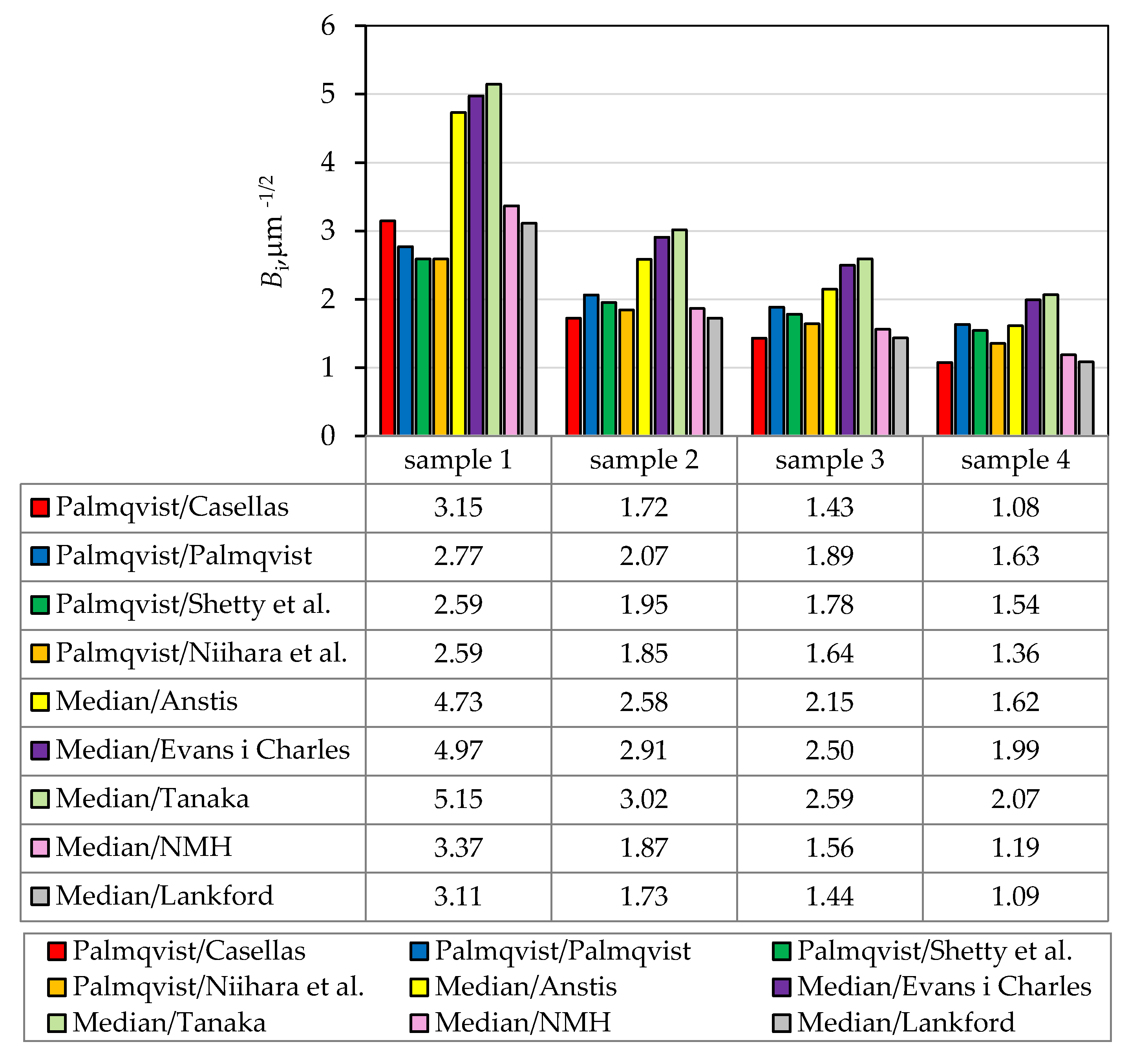
| Component | MgO | Fe2O3 | SiO2 | Na2O | CaO | Al2O3 |
|---|---|---|---|---|---|---|
| wt. % | 0.066 | 0.015 | 0.02 | 0.05 | 0.013 | balance |
| Component | Y2O3 | ZrO2 |
|---|---|---|
| mol. % | 3 | 97 |
| Sample | wt. (Ceramic Powder), % | Ceramic Powder Composition | wt. (MgAl2O4) *, % | wt. (Dolapix CE 64) *, % |
|---|---|---|---|---|
| 1 | 70 | 100 wt. % Al2O3 | 0.2 | 0.15 to 1.0 |
| 2 | 70 | 99 wt. % Al2O3 + 1 wt. % ZrO2 | 0.2 | 0.2 to 1.0 |
| 3 | 70 | 95 wt. % Al2O3 + 5 wt. % ZrO2 | 0.2 | 0.4 to 1.2 |
| 4 | 70 | 90 wt. % Al2O3 + 10 wt. % ZrO2 | 0.2 | 0.8 to 1.4 |
| Crack Type | Model | Author(s) of Model |
|---|---|---|
| Palmqvist | Casellas [2,30] | |
| Palmqvist | Palmqvist [31] | |
| Palmqvist | Shetty et al. [32] | |
| Palmqvist | for 0.25 < l/a < 2.5 | Niihara et al. [32] |
| Median | Anstis [1,2,33] | |
| Median | Evans and Charles [34] | |
| Median | Tanaka [34] | |
| Median | Niihara, Morena and Hasselman (NMH) [35] | |
| Any kind | Lankford [32] |
| Sample | wt. (Ceramic Powder), % | Ceramic Powder Composition | wt. (MgAl2O4) *, % | Optimal Amount of Dispersant * |
|---|---|---|---|---|
| 1 | 70 | 100 wt. % Al2O3 | 0.2 | 0.25 wt. % |
| 2 | 70 | 99 wt. % Al2O3 + 1 wt. % ZrO2 | 0.2 | 0.30 wt. % |
| 3 | 70 | 95 wt. % Al2O3 + 5 wt. % ZrO2 | 0.2 | 0.70 wt. % |
| 4 | 70 | 90 wt. % Al2O3 + 10 wt. % ZrO2 | 0.2 | 1.00 wt. % |
| pH Value | Sample | |||
|---|---|---|---|---|
| 100 wt. % Al2O3 | 99 wt. % Al2O3 + 1 wt. % ZrO2 | 95 wt. % Al2O3 + 5 wt. % ZrO2 | 90 wt. % Al2O3 + 10 wt. % ZrO2 | |
| ± s | 8.92 ± 0.06 | 8.36 ± 0.05 | 8.52 ± 0.09 | 8.26 ± 0.10 |
| Sample | Composition | Bulk Density, g/cm3 | Relative Density, % | Total Porosity, % | HV30 | c/a |
|---|---|---|---|---|---|---|
| 1 | 100 wt. % Al2O3 | 3.882 | 98.04 | 1.96 | 1679 | 3.89 |
| 2 | 99 wt. % Al2O3 + 1 wt. % ZrO2 | 3.920 | 98.21 | 1.79 | 1447 | 2.82 |
| 3 | 95 wt. % Al2O3 + 5 wt. % ZrO2 | 3.931 | 96.43 | 3.57 | 1328 | 2.59 |
| 4 | 90 wt. % Al2O3 + 10 wt. % ZrO2 | 3.938 | 94.14 | 5.86 | 1153 | 2.28 |
| Crack Type | Author(s) of Model | KIC, MPa m1/2 | |||
|---|---|---|---|---|---|
| Sample 1 (100 wt. % Al2O3) | Sample 2 (99 wt. % Al2O3 + 1 wt. % ZrO2) | Sample 3 (95 wt. % Al2O3 + 5 wt. % ZrO2) | Sample 4 (90 wt. % Al2O3 + 10 wt. % ZrO2) | ||
| Palmqvist | Casellas [2,30] | 5.23 | 8.24 | 9.09 | 10.50 |
| Palmqvist | Palmqvist [31] | 5.94 | 6.87 | 6.90 | 6.92 |
| Palmqvist | Shetty et al. [32] | 6.36 | 7.27 | 7.30 | 7.32 |
| Palmqvist | Niihara et al. [32] | 6.36 | 7.69 | 7.93 | 8.33 |
| Median | Anstis [1,2,33] | 3.48 | 5.49 | 6.06 | 7.00 |
| Median | Evans and Charles [34] | 3.31 | 4.88 | 5.21 | 5.67 |
| Median | Tanaka [34] | 3.20 | 4.70 | 5.02 | 5.47 |
| Median | Niihara, Morena and Hasselman (NMH) [35] | 4.89 | 7.60 | 8.33 | 9.51 |
| Any kind | Lankford [32] | 5.29 | 8.22 | 9.06 | 10.41 |
© 2019 by the authors. Licensee MDPI, Basel, Switzerland. This article is an open access article distributed under the terms and conditions of the Creative Commons Attribution (CC BY) license (http://creativecommons.org/licenses/by/4.0/).
Share and Cite
Žmak, I.; Ćorić, D.; Mandić, V.; Ćurković, L. Hardness and Indentation Fracture Toughness of Slip Cast Alumina and Alumina-Zirconia Ceramics. Materials 2020, 13, 122. https://doi.org/10.3390/ma13010122
Žmak I, Ćorić D, Mandić V, Ćurković L. Hardness and Indentation Fracture Toughness of Slip Cast Alumina and Alumina-Zirconia Ceramics. Materials. 2020; 13(1):122. https://doi.org/10.3390/ma13010122
Chicago/Turabian StyleŽmak, Irena, Danko Ćorić, Vilko Mandić, and Lidija Ćurković. 2020. "Hardness and Indentation Fracture Toughness of Slip Cast Alumina and Alumina-Zirconia Ceramics" Materials 13, no. 1: 122. https://doi.org/10.3390/ma13010122
APA StyleŽmak, I., Ćorić, D., Mandić, V., & Ćurković, L. (2020). Hardness and Indentation Fracture Toughness of Slip Cast Alumina and Alumina-Zirconia Ceramics. Materials, 13(1), 122. https://doi.org/10.3390/ma13010122








